Illinois AGD e-Advisor 2015 Spring Edition
President’s Message
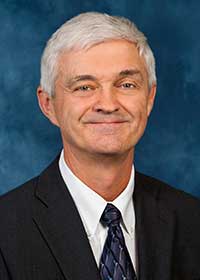
Larry Williams,
DDS, MAGD, ABGD
Larry Williams, DDS, MAGD, ABGD
As the newly elected President of the Illinois Academy of General Dentistry, I want to personally take a moment to thank you for your support of the two most important aspects of our profession- the pursuit of life-long learning and the support of organized dentistry. As a member of the United States Navy Dental Corps, my 30 years of service are a testament to life-long learning: two post-grad training opportunities, achieving the American Board in General Dentistry, and my Fellowship, Mastership, and Life-Long Service and Recognition Awards in the AGD.
Life-long learning and the support of organized dentistry are vital to our profession’s very existence. Each of us is licensed to provide dental care that meets or exceeds the needs and expectations of our patients and the community. The only way to achieve this is through our pursuit of knowledge of new techniques, materials, and practice improvement. The support of our professional organizations goes hand in hand with this. The practice of general dentistry is the basis of our existence and the Illinois AGD is the only organization solely dedicated to providing support for the general dentists in Illinois. I encourage each member to invite a nonmember to the next CE event you attend. The more members we have in Illinois, the greater our voice and our ability to promote the practice of general dentistry in Illinois.
In closing, I want to thank you for your membership and support of our great profession. In my new career as a professor at the Midwestern University College of Dental Medicine- Illinois, I am excited about our future generation of dentists. But this excitement comes with some degree of hesitance. Our newest generation of dentists needs our support and mentorship. Seek out the new dentists in your community and make sure they feel welcome and encourage their participation in IL AGD activities. They are our future and need to have our support. I look forward to seeing you at the next IL AGD CE event!
Larry
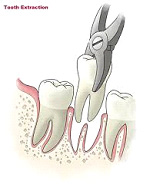 On Monday you extracted two of Ms. Miller’s impacted wisdom teeth. You sent her home after telling her to take an over-the-counter nonsteroidal anti-inflammatory drug (NSAID) for the pain. You also told her to expect a little oozing and to “call if you have any problems.” Ms. Miller didn’t have any NSAIDs at home, so she took aspirin instead. Late Tuesday, she notices what she later describes as “a lot of bleeding” from the extraction site. Ms. Miller considers filing a lawsuit and may have a case that holds up in court.This situation might have been avoided through comprehensive patient education. Here is how to ensure you provide sufficient education and how you can use other strategies to protect yourself against liability after a tooth extraction.Obtain informed consent
On Monday you extracted two of Ms. Miller’s impacted wisdom teeth. You sent her home after telling her to take an over-the-counter nonsteroidal anti-inflammatory drug (NSAID) for the pain. You also told her to expect a little oozing and to “call if you have any problems.” Ms. Miller didn’t have any NSAIDs at home, so she took aspirin instead. Late Tuesday, she notices what she later describes as “a lot of bleeding” from the extraction site. Ms. Miller considers filing a lawsuit and may have a case that holds up in court.This situation might have been avoided through comprehensive patient education. Here is how to ensure you provide sufficient education and how you can use other strategies to protect yourself against liability after a tooth extraction.Obtain informed consentObtaining informed consent before surgery can help you avoid litigation afterwards by ensuring the patient understands the surgery and its risks. Informed consent is much more than simply obtaining the patient’s signature on a piece of paper. In fact, that should be the last step in the process.If necessary, use an interpreter for a patient who doesn’t speak English as a primary language. The interpreter should be a professional and not the patient’s family member or friend. The consent form the patient signs should include:
- a statement that the person signing the form understands the treatment and any alternative treatments (including no treatment)
- a listing of potential complications, with the acknowledgement that the list is not comprehensive (such as “These complications include, but are not limited to, …”)
- a place for the patient to sign and for a witness to sign (the witness is simply attesting that the person signed the form, not that informed consent has been completed).
Sample Consent Forms can be found on Dentist’s Advantage’s website as a downloadable PDF – in both English and Spanish – visit the site here.
Document that the consent was signed and keep a copy in the patient’s medical record. You may also choose to give a copy to the patient.
Provide patient education
Patient teaching is essential not only to ensure optimal outcomes, but also to protect you against possible litigation. It can play a significant role in helping patients understand what to expect after surgery and providing them information so they know when they need to seek help.
Discuss areas such as proper use of an ice pack, use of medications, how to apply and change the gauze pack, diet, oral hygiene, lingering effects of anesthesia, and the type of bleeding that is expected (see Patient post-extraction education).
Have instructions available in the patient’s preferred language, and remember to document the following:
- topics covered
- the patient’s understanding of the material—ask the patient to repeat the instructions back to you to ensure understanding
- the fact that a printed instruction sheet was given.
Keep a copy of the instruction sheet, signed by you and the patient, in the medical record. If permitted by the patient, include a family member or friend in the teaching. This strategy provides a backup in case the patient needs help at home.
Manage pain appropriately
Patients with unrelieved pain are likely not going to be happy with their care, and, therefore, be more likely to pursue litigation should unforeseen problems occur. Be sure patients understand they should not take aspirin, but instead take over-the-counter NSAIDs as needed. Remind them to follow the label instructions to avoid taking too much.
Take all complaints seriously
All dentists have some challenging patients. For example, a patient might call the office frequently to ask questions about signs and symptoms that, upon examination, turn out to be nonexistent. When a patient contacts you after tooth extraction surgery to complain about excess pain or bleeding, it can be tempting to not give the call your full attention. Keep in mind that you still need to conduct a thorough assessment and have the patient come to the office if there is any suspicion in your mind that a complication may have occurred. If you need to examine the patient who has untoward symptoms, be sure to document the visit in detail, including signs and symptoms of the problem, what you found on examination, and how you decided to follow up.
At the other end of the spectrum is the patient who is reluctant to speak up because of an unwillingness to “bother you.” In this case, take extra care to emphasize the need for the patient to contact you if there are any unexpected problems. In essence, knowing your patient will help you ensure follow-up care is given appropriately.
Document completely and consistently
The best protection against a lawsuit is effective documentation. In addition to documenting informed consent and patient education, include details about the procedure such as the type and amount of anesthesia given and how the patient tolerated the procedure. Document follow-up visits as well, and if a patient fails to return to be checked after surgery, note the efforts you made to try to encourage the patient to make a post-surgery visit.
Patient post-extraction education
Telling patients what they should do after a tooth extraction should be supplemented with printed
guidance. Here are examples of key points you should include.
Anesthesia: The feeling of numbness will begin to wear off in 30 minutes to 4 hours. Until that time, avoid all hot foods or liquids, and do not chew. (This prevents accidentally burning or biting the lips, cheeks, inside of your mouth or tongue until feeling has returned.) If you have any concerns about prolonged numbness, call the office.
Gauze pack: Fold the gauze into a small pack and place it over the site where the tooth was removed. There should be firm pressure on site. Keep firm biting pressure on the gauze for one to two hours. Change the pack every 15 to 30 minutes. You can stop applying the gauze after 1 to 2 hours or when bleeding has stopped.
Bleeding: It’s normal for the extraction site to bleed slightly or ooze blood for 12 to 24 hours following surgery.
Ice pack: For the first 2 to 8 hours after surgery, apply ice packs to the outside of the face over the area where the tooth was removed. Hold the ice pack in place for 15 minutes or so, and then remove it for 15 minutes. This will help reduce discomfort and swelling. Cover the ice pack with a thin towel so the pack is not directly on your skin.
Medications: Do NOT take any products with aspirin because they may increase bleeding. In most cases, a pain medication without aspirin that’s available over the counter (in a store) will give you good pain relief. Use prescription and over-the-counter medications as instructed on the label. If you have any bad side effects, stop taking the medications and call the office. If you have a serious side effect or an allergic reaction, seek medical care immediately.
Diet: Eat a liquid or soft diet for the first 12 to 24 hours. Drink plenty of liquids for the first day or two after surgery. Don’t use a straw because it may dislodge (break up) the blood clot that is forming where your tooth was removed.
Oral hygiene: Clean your mouth as usual, but avoid the site where your tooth was removed. Do not rinse or swish your mouth with for the first 24 hours after surgery. Don’t smoke for 24 hours after surgery.
Possible problems: Be alert for:
Dry socket. You might have a dry socket if you have constant moderate to severe pain, a bad taste, putrid odor, and poor clot formation at extraction site. If you have any of these symptoms, call the office immediately.
Fever. Check your temperature for the first 24 to 48 hours after surgery. Call the office if you have a temperature higher than normal (98.6° F).
Swelling. You can expect to have some swelling during the first 24 to 48 hours after surgery. If you have a lot of swelling or the swelling continues after 48 hours, call the office. In addition to the above information, include written instructions telling the patient to call the office if he or she has any concerns or questions. Write the phone numbers to use during and after business hours clearly and prominently on the form, or consider having them preprinted. You don’t want a patient’s needs to be delayed because a phone number is illegible.
Finally, consider adding a note about the importance of seeking help when it looks like a serious problem is developing. For example, “If you experience any severe swelling, prolonged bleeding, severe or prolonged pain, high fever, dizziness, allergic reaction, or other problems that concern you, please call us immediately. If you can’t reach us of haven’t heard back from us in a reasonable time frame, go to the emergency department for immediate medical attention.”
Source: Dentist’s Advantage and the National Society of Dental Practitioners. Post-extraction instructions. 2008.
Cynthia Saver, MS, RN,
President,
CLS Development, Columbia,
Maryland
For additional information on professional liability please read Dentist’s Advantage ground-breaking report: Professional Liability in the Dental Practice: Lessons Learned from Closed Claims.
The 5 year dental liability report includes:
- Statistical data and analysis of dental malpractice claims and license defense claims
- Legal case studies and risk management recommendations
- Highlights of a survey among 1,277 dentists on issues impacting dental liability claims
For questions or more information about this report, please call Dentist’s Advantage at 1-888-778-3981
Resources
Dentist’s Advantage and the National Society of Dental Practitioners. Post-extraction instructions. 2008.
American Dental Association. Cochrane review finds acetaminophen effective for pain relief after wisdom tooth
extraction. http://www.ada.org.
This risk management information was provided by Dentist’s Advantage, the leading provider of dentists’ professional liability insurance coverage for over 50 years. Reproduction without permission of the publisher is prohibited. For questions, call (888) 778-3981. www.dentists-advantage.com. Reprinted with permission from Dentist’s Advantage.
Dr. Mohamed Harunani, AGD National Treasurer and IL AGD Past President, said during his presentation on Succession Planning: “Leaders are not born, they volunteer.”The AGD Leadership Symposium focused on developing leadership skills in our professional, volunteer and private lives. Volunteering is an opportunity to grow personally and professionally while serving others. AGD offers many opportunities for members to become involved and volunteer both at the local and national levels. Volunteering is a great way to gain new strengths and skills that will help you be more successful in your dental practice and your professional career. Click here to get involved!
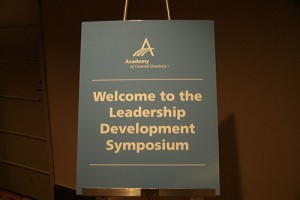 AGD Leadership Conference AGD Leadership Conference |
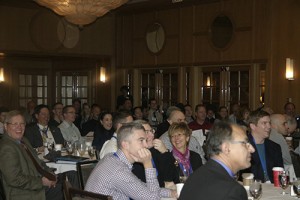 AGD Leadership Development Symposium AGD Leadership Development Symposium |
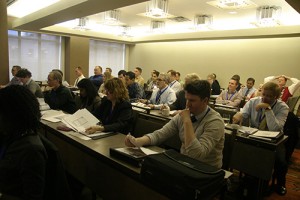 Dr. Brenden Moon, Dr. Brenden Moon,AGD Leadership Conference |
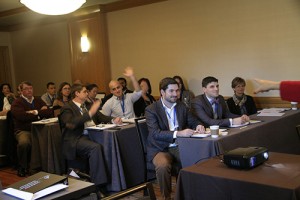 Dr. Cheryl Mora at the AGD Leadership Class “Displaying Dynamic Leadership in a Volunteer Position” Dr. Cheryl Mora at the AGD Leadership Class “Displaying Dynamic Leadership in a Volunteer Position” |
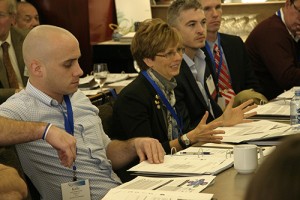 Dr. Cheryl Mora, Chair Membership Council; “Communication Networks and Influencing Others” Dr. Cheryl Mora, Chair Membership Council; “Communication Networks and Influencing Others” |
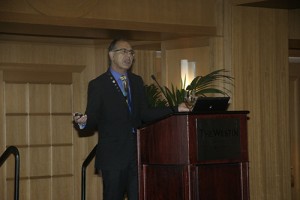 Dr. Mohamed Harunani, Treasurer AGD; IL AGD Past President giving a presentation on “How to Find Volunteer Leaders and Succession Planning” Dr. Mohamed Harunani, Treasurer AGD; IL AGD Past President giving a presentation on “How to Find Volunteer Leaders and Succession Planning” |
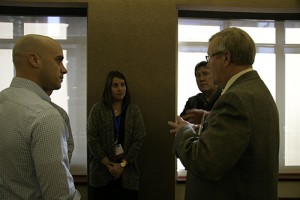 Dr. Robert Kozelka, IL AGD Regional Director Dr. Robert Kozelka, IL AGD Regional Director |
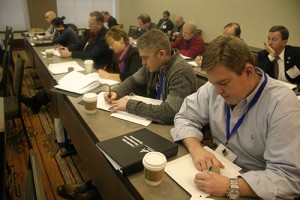 Joe Wolski, D-4 Midwestern University College of Dental Medicine Joe Wolski, D-4 Midwestern University College of Dental Medicine |
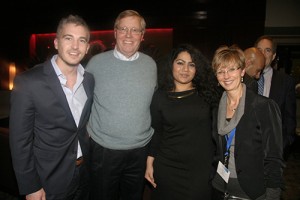 Joe Wolski, D-4 MWU; Dr. Robert Kozelka, IL AGD Regional Director; Roma Fatima, A-2 UIC COD; Dr. Chery Mora, IL AGD Imm. Past President & Chair, AGD Membership Council Joe Wolski, D-4 MWU; Dr. Robert Kozelka, IL AGD Regional Director; Roma Fatima, A-2 UIC COD; Dr. Chery Mora, IL AGD Imm. Past President & Chair, AGD Membership Council |
The Illinois AGD had the opportunity to participate in the UIC COD 2015 Career Fair on January 22nd. During the fair, AGD officers and members met with the students from all the classes and educated them on the benefits of their AGD membership. Many of the students were not aware of the 50 hours of continuing education credit they can earn as students that will apply towards their Fellowship Award when they graduate from dental school. Networking through volunteer leadership is excellent way for students and new dentists to learn about career opportunities, and the AGD Career Center helps to prepare for graduation by posting resumes and job listings online.
AGD’s award winning publications, General Dentistry and AGD Impact and the online practice management resources are all great ways for students and new dentists to get the information they need to jumpstart their careers. And what new dentist doesn’t want to save money? The AGD Member Savings & Offers program provides discounts on personal and professional products and services to help new dentists pay off their student loans and prepare for their new careers.
AGD’s Student’s Transition Manual has just been updated and is online. Look for it in the Student Resource Section on agd.org. Check out Ilagd.org for our 2015 CE programs –many of which are free to dental students and residents. The dental students are embarking on an exciting journey and the AGD and the IL AGD will be there to support the students during their transition from student to new dentist. From continuing education and leadership opportunities to one-on-one expert advice, the AGD has all the tools needed to plan ahead for a successful dental career.
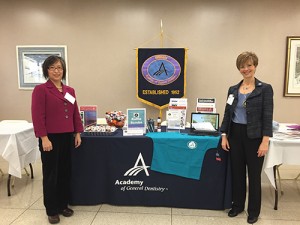 Dr. Judy Fan-Hsu and Dr. Cheryl Mora, UIC COD Career Fair-IL AGD table Dr. Judy Fan-Hsu and Dr. Cheryl Mora, UIC COD Career Fair-IL AGD table |
 UIC COD Career Fair, IL AGD Table UIC COD Career Fair, IL AGD Tablewith Dr. Scott Miller |
 Drs. Sue Bishop and Joyce Gomez Drs. Sue Bishop and Joyce GomezUIC COD Career Day- OSF St. Francis GPR |
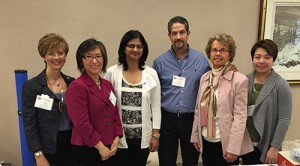 Drs. Cheryl Mora, Judy Fan-Hsu, Drs. Cheryl Mora, Judy Fan-Hsu,Preethi Mohan, Scott Miller, Sue Bishop and Joyce Gomez UIC COD Clinic & Research Day |
Student CE Program February 12, 2015
It was a cold night on February 12, but close to 70 students from University of Illinois at Chicago College of Dentistry ventured out to learn about the business of dentistry. The American Student Dental Association (ASDA) and the Hispanic Student Dental Association (HSDA) organized a panel discussion from a group of experts in the fields of accounting, banking, and practice transitions. The IL Academy of General Dentistry was invited to speak about organized dentistry and its role in developing professional relationships and obtaining high quality dental continuing education. The adage “All for one and one for all” may be an old quote, but it states simply why organized dentistry is so important to our profession: In numbers there is strength. Member dentists love to help their colleagues and those dentists who develop networks through organized dentistry find more satisfaction and success in their dental practices.
The panelists at the program were from the Abrix Group, Accounting and Healthcare Management Consultants, ADS Midwest Practice Transitions and Todd Erdman, J.D., Dental Practice Law and Paul Motter, Bank of America: Practice Solutions. The students learned about associateships, buying practices, how to handle student debt, and the importance of being financially responsible as both students and new dentists. Dr. Cheryl Mora, IL AGD Immediate Past President, closed the program by emphasizing that new dentists need to surround themselves with knowledgeable people who will help them achieve their goals and be successful in the dental careers. Understanding “you don’t know what you don’t know” is the first step in learning that a dentist cannot possibly be a master of everything right out of dental school and connecting with business and dental professionals is key to being successful and happy in one’s career. Being a member of a dental organization such as the AGD is like having hundreds of experts as close as a phone call or an email away. Why not take advantage of all the benefits we in AGD have to offer? If you want to learn more about AGD contact Dr. Cheryl Mora at [email protected].
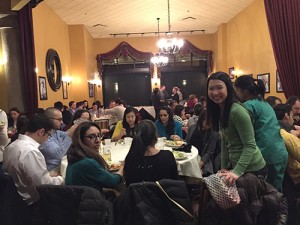 UIC COD ASDA HSDA UIC COD ASDA HSDAPractice Management Panel Discussion Katrina Lo A-1 UIC IL AGD Rep |
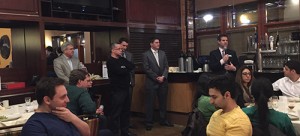 UIC COD ASDA HSDA UIC COD ASDA HSDAPractice Management Panel Discussion Panelists |
University of Illinois at Chicago College of Dentistry D-4 Case Presentations
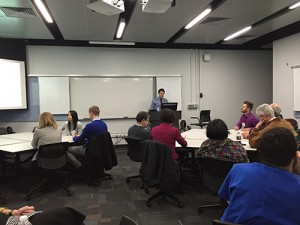 Christopher Greenwaldt Christopher Greenwaldtpresenting at the UIC COD D-4 Case Presentations |
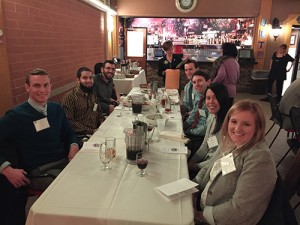 UIC COD Case Presentation Dinner UIC COD Case Presentation Dinnerat Juts@Pompeii |
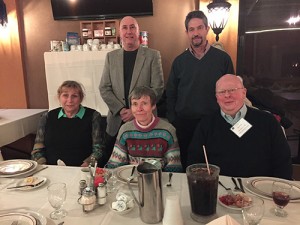 Drs. Sue Mayer, Spencer Bloom, Drs. Sue Mayer, Spencer Bloom,Scott Miller and Dr. Dick Tatro and his wife Cindy |
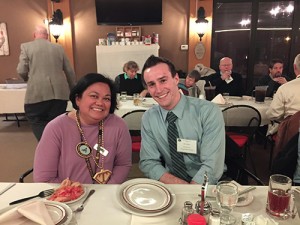 Drs. Theresa Lao & Ben Youel Drs. Theresa Lao & Ben Youel |
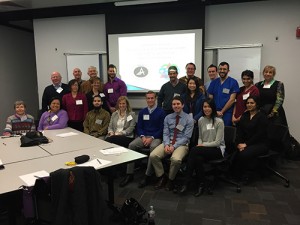 UIC COD D-4 Case Presentations UIC COD D-4 Case PresentationsStudents and IL AGD Dentist judges |
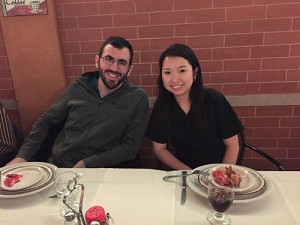 UIC IL AGD Reps Dan Pagel UIC IL AGD Reps Dan PagelD-1 & Katrina Lo A-1 |
Illinois Academy of General Dentistry Presents Twenty-second Annual Ted Weclew Memorial Lecture
DDS, MAGD
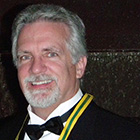 by William M Lawley, DDS, MAGDOn February 25, 2015 one hundred and fourteen dentists, staff and students gathered in the ADA Auditorium for a fast paced informative lecture by three powerhouse lecturers, Drs. Lou Graham, Ron Kaminer, and Jack Grifffin on The Busier, Better, Blissful Practice.Dr. Graham received his D.D.S. from Emory University. He is the founder of the Catapult Group, a continuing education company whose philosophy and programs use contemporary, interactive formats to integrate time-proven conservative dentistry with 21st century materials and techniques. He is the former Dental Director of the University of Chicago’s Department of Dentistry. Presently he practices in his multi-speciality practice group University Dental Professionals in Chicago, IL. – Hyde Park.Dr. Kaminer received his D.D.S. from SUNY at Buffalo School of Dental Medicine. He evaluates new dental materials for the Catapult Group and sits on the advisory boards and is a clinical consultant for numerous dental manufacturers. He has authored numerous articles on dental lasers and minimally invasive dentistry, is a frequent contributor to Mentor magazine and is an associate editor for Dental Product Shopper.Dr. Griffin received his D.M.D. from Southern Illinois University. Dr. Griffin is one of a hand full of dentists awarded by his peers Diplomat status with the American Board of Aesthetic Dentistry (ABAD), accreditation with the American Academy of Cosmetic Dentistry (AACD), and Mastership in the Academy of General Dentistry (AGD). He is affiliated with the Catapult Group. He has had many articles published in professional journals such as Practical Procedures and Aesthetic Dentistry, Journal of Oral Health, Canadian Journal of Restorative Dentistry and Prosthodontics, Compendium, Dentistry Today, Inside Dentistry, Dental Economics, and Contemporary Esthetics, Dental Products Report, and Dental Equipment and Materials.These three dynamos fed off one another and perfectly lead each other into their areas of expertise. It was delightful watching their exquisite interplay as if it was meticulously rehearsed.
by William M Lawley, DDS, MAGDOn February 25, 2015 one hundred and fourteen dentists, staff and students gathered in the ADA Auditorium for a fast paced informative lecture by three powerhouse lecturers, Drs. Lou Graham, Ron Kaminer, and Jack Grifffin on The Busier, Better, Blissful Practice.Dr. Graham received his D.D.S. from Emory University. He is the founder of the Catapult Group, a continuing education company whose philosophy and programs use contemporary, interactive formats to integrate time-proven conservative dentistry with 21st century materials and techniques. He is the former Dental Director of the University of Chicago’s Department of Dentistry. Presently he practices in his multi-speciality practice group University Dental Professionals in Chicago, IL. – Hyde Park.Dr. Kaminer received his D.D.S. from SUNY at Buffalo School of Dental Medicine. He evaluates new dental materials for the Catapult Group and sits on the advisory boards and is a clinical consultant for numerous dental manufacturers. He has authored numerous articles on dental lasers and minimally invasive dentistry, is a frequent contributor to Mentor magazine and is an associate editor for Dental Product Shopper.Dr. Griffin received his D.M.D. from Southern Illinois University. Dr. Griffin is one of a hand full of dentists awarded by his peers Diplomat status with the American Board of Aesthetic Dentistry (ABAD), accreditation with the American Academy of Cosmetic Dentistry (AACD), and Mastership in the Academy of General Dentistry (AGD). He is affiliated with the Catapult Group. He has had many articles published in professional journals such as Practical Procedures and Aesthetic Dentistry, Journal of Oral Health, Canadian Journal of Restorative Dentistry and Prosthodontics, Compendium, Dentistry Today, Inside Dentistry, Dental Economics, and Contemporary Esthetics, Dental Products Report, and Dental Equipment and Materials.These three dynamos fed off one another and perfectly lead each other into their areas of expertise. It was delightful watching their exquisite interplay as if it was meticulously rehearsed.
Dr. Graham discussed his views on conservative dentistry emphasizing tooth preservation. Class V restorations can easily be treated quickly and conservatively with a flowable composite – Beautifil Flow which has the same wear as a microfil composite. He talked about his 3 C’s of prevention – check, control, and contain. For operative dentistry he charges by the hour not by the surface.
Dr. Kaminer touched on restorative procedures. One in particular was using Grand Tec by VOCO which is bundle of parallel light curable fibers, which can be bonded to adjacent teeth over an implant. A heavy flowable like Beautifil Flow can be placed and sculptured into a tooth as the implant heals. Uveneer System consists of shells that can be used for placing direct composite veneers on anterior teeth. BioClear makes great matrices for closing diastemas and eliminating black triangles. We should think about selectively etching our restorations and using a universal bonding agent. We were encouraged to forget about total etch.
Dr. Griffin discussed cementation protocols.To cement a crown 3-4mm of axial height and 1-1.5mm of occlusal reduction is needed, otherwise bond the restoration. He will keep his margins super-gingival for E-Max and Zirconia whenever possible. When making depth cuts, he likes to use a 330 bur which will give the 1.5 – 2mm depth for proper reduction. He prefers Ceramir cement when cementing the restorations. Advantages of Ceramir cement are its regenerative properties, easy cleaning up and it’s efficiency. Advantages of bonding a restoration are 1. more retention if tooth is compromised, 2. better esthetics and 3. strengthens the E-Max. With more milled restorations being produced, labs are employing more gamers to operate the milling machines. This may give us an edge at trying to negotiate our lab fees.
This program was filled with many pearls which the attendees could take back to the office and utilize right away. This program was another example of the fine continuing education Illinois AGD provides its members. Please tell your colleagues of this valuable resource and urge them to become members of the Academy of General Dentistry.
Officers from the national office of the Academy of General Dentistry: President Dr. W. Carter Brown, President-Elect Dr. Maria Smith, Vice-President Dr. W. Mark Donald, Treasurer Dr. Mohamed Harunani and Immediate Past-President Dr. Linda Edgar addressed the audience and encouraged members to discuss the benefits of AGD to their non-member colleagues. CEO Mr. John Thorner discussed AGD webinars and the new blended learning opportunities that the AGD is offering in conjunction with the 2015 Annual Session in San Francisco.
- Bisco represented by Norma Gilich RDH
- Dentist’s Advantage represented by Maria Santiago
- Doxa represented by Gwen Kovar
- Garrison Dental represented by Randy Drumm
- HiPoint Dental Lab represented by Daniel Holloway
- Kettenbach represented by Tim St. Clair
- Premier
- PNC Bank represented by Jose Prado and Patricia Dewey
- Shofu
- Sequoia represented by David Johnson and Julie Wanneumuelher
- UltraLight represented by Ron Nguyen
- VOCO represented by Jason Dempsey and Joe Romaine
- Vatech represented by Joseph Bunney
The Illinois Academy of General Dentistry participated in the 2015 University of Illinois at Chicago College of Dentistry Clinic & Research Day on March 5th. The College of Dentistry’s annual Clinic and Research Day provides a forum for students, postgrads, and research staff to present research achievements to the members of the College and larger research community. Additionally, Research Day offers continuing education opportunities, dental products and service exhibits, a keynote lecture and student awards. The keynote speaker for Clinic and Research Day 2015 was Dr. James E. Melvin, Chief of the Section of Secretory Mechanisms and Dysfunction of the National Institute of Dental and Craniofacial Research of the National Institute of Health. His presentation was: “Clinical Research Studies at the NIDCR Division of Intramural Research.”
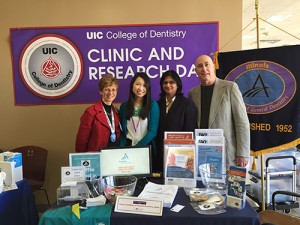 Dr. Cheryl Mora, Katrina Lo-A-2, Dr. Cheryl Mora, Katrina Lo-A-2,Dr. Preethi Mohan and Dr. Spencer Bloom |
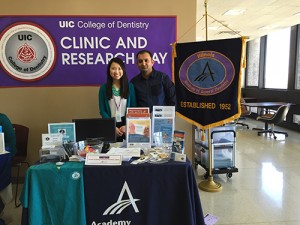 Katrina Lo UIC IL AGD Rep Katrina Lo UIC IL AGD Repand Sameer Kapil |
 Natasha Kanchwala UIC IL AGD Rep Natasha Kanchwala UIC IL AGD Rep |
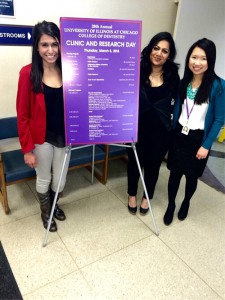 UIC IL AGD Student Reps UIC IL AGD Student RepsNatasha Kanchwala, Roma Fatima and Katrina Lo |

